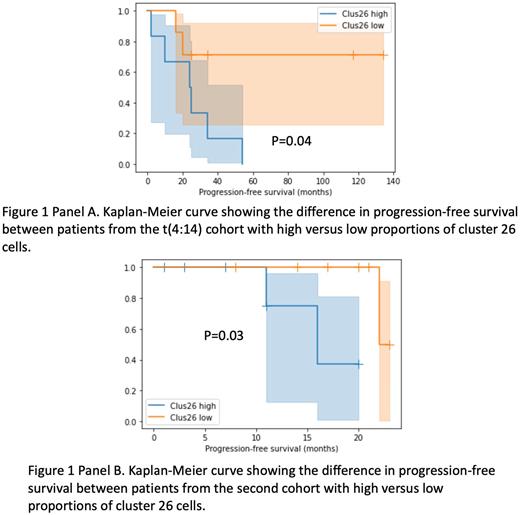Abstract
Background Multiple Myeloma (MM) is the second most common haematologic malignancy and patients with high risk MM have adverse outcomes. Translocation (4;14) occurs in 15% of MM and is associated with inferior survival. However, outcomes are heterogeneous even within this subset of patients. We set out to identify factors that correlated with progression free survival (PFS) in a cohort of t(4;14) patients by using high dimensional profiling of the malignant plasma cells (PCs) and tumor micro-environment through single cell multi-omics.
Methods We analysed diagnostic bone marrow (BM) samples from 13 patients with t(4;14) MM using the ESCAPE™ platform from Singleron Biotechnologies which simultaneously measures gene and cell surface protein expression of 62 proteins in single cells. Cryopreserved BM samples were stained with antibodies and subsequently sorted on CD138 expression. The CD138 positive and negative fractions were recombined at a 1:1 ratio for analysis using the 10x Genomics 3' RNAseq kit. Resulting data were analyzed with Singleron Biotechnology's MapSuite™ single cell analytics platform. Subsequent validation of the t(4;14) findings were performed using the 5' chemistry version of ESCAPE™ with the 10x Genomics RNAseq platform.
Results All patients received either bortezomib or thalidomide-based induction and had a median age of 63 years. Median PFS and overall survival (OS) were 22 and 34 months respectively. Consistent with published bulk gene expression data, MMSET was overexpressed in all PCs, while FGFR3 expression was heterogeneous. No gene or protein expression patterns within the PCs were identified that correlated with PFS or OS. In the tumor microenvironmental compartment, we identified a CD3+ population (cluster 26) that had not been previously annotated in published single cell RNA-seq data. These cells were CD45+ and CD138- at both the protein and RNA level, suggesting they are not PCs. Independent bioinformatics tools "MapCell" and "DISCO" both identified cluster 26 cells as T cells. The proportion of cluster 26 cells among non-PCs correlated negatively with PFS (P=0.04, logrank test), with samples containing a higher proportion of these cells having an inferior PFS compared to those with a lower proportion (Figure 1 panel A).
We subsequently demonstrated that the T cells identified in cluster 26 could also be detected in BM samples from a separate cohort of MM patients analysed using the ESCAPE platform. These patients were treated with daratumumab in the first line or relapsed setting and included patients without t(4;14). Analysis of 15 patients from this cohort revealed that the percentage of cluster 26 cells retained its negative correlation with PFS (P=0.03, logrank test) (Figure 1 panel B).Conclusions We identified a T-cell population which may have prognostic significance in patients with t(4;14 )MM. Interestingly, this population also retains its negative correlation with PFS in a cohort of non t(4;14) patients, suggesting it may have a broader significance across cytogenetic subtypes of MM. The second cohort of patients were treated with daratumumab, hence the novel population may also be relevant in the response to anti -CD38 monoclonal antibody therapy. These data highlight the potential of single cell multi-omic analysis to identify immune micro-environmental signatures that correlate with clinical outcomes in MM. Further work is ongoing to definitively characterize these cells and explore the biological basis for their clinical impact.
Disclosures
de Mel:Pfizer: Other: Advisory board . Soekojo:Pfizer: Other: advisory board. Ooi:Amgen: Honoraria; Pfizer: Honoraria; Abbvie: Honoraria; Astellas: Honoraria; Janssen: Honoraria; Novartis: Honoraria; BMS: Honoraria. Chng:Hummingbird: Research Funding; Takeda: Honoraria; Novartis: Honoraria; Abbvie: Honoraria; BMS: Honoraria; Celgene: Honoraria, Research Funding; J&J: Honoraria, Research Funding; Amgen: Honoraria.
Author notes
Asterisk with author names denotes non-ASH members.


This feature is available to Subscribers Only
Sign In or Create an Account Close Modal